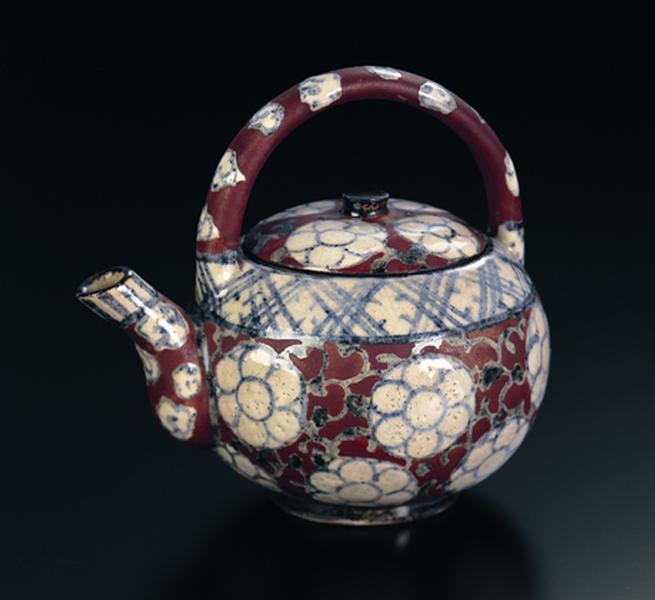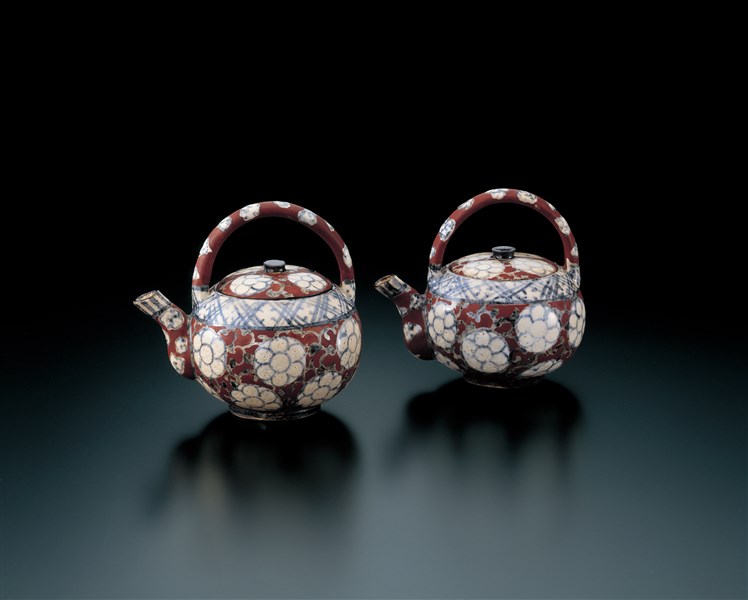乾山色絵菊文手付汁次
- 江戸時代
- 18c
- H-10.4 D-8.6 W-10.7
尾形乾山
尾形乾山(おがたけんざん 1663~1743)
乾山は、寛文3年(1663)京都の富裕な呉服商尾形宗謙(おがたそうけん)の三男として生まれました。兄は画家の光琳です。二人の性格は対象的で、光琳が派手好みであったのに対し乾山は内省的、隠遁的な性格の持主であったといわれています。
野々村仁清に陶芸を学んだ乾山は、元禄12年(1699)37歳のとき京都市の鳴滝に開窯しました。そして正徳2年(1712)50歳の乾山は、京市内の二条丁子屋町に移住し、多くの作品を手がけ「乾山焼」として世にもてはやされました。鳴滝時代の末期からこの丁子屋町時代にかけて兄の光琳は絵付で乾山を助け、兄弟合作の作品が数多く残されています。
享保16年(1731)69歳の頃に江戸に下り寛永寺(かんえいじ)領入谷(いりや)に窯を築いて晩年を送りました。そして81歳で没するまで江戸に在住し陶器や絵画の制作に手腕を発揮しました。
乾山の作品は陶芸作品のみならず書や絵画においても、俗気を脱したおおらかで文人的な洒脱味があります。陶芸作品においては成形、施釉、焼成は他の専門的な陶工に任せたり、絵付についても光琳との合作以外に複数の専門画家が携わっていたと思われるなど、基本的には工房生産という態勢をとっていたようです。しかし、乾山の指導のもとにつくられたやきものには、その大胆なデザイン感覚とともに乾山特有の芸術性が溢れ、乾山その人とふれあうような親しみが感じられるのです。
乾山銹絵染付掻落絵替汁次
乾山銹絵染付梅波文蓋物
乾山立鶴図黒茶碗
乾山銹絵染付桔梗図筒向付
乾山銹絵染付草文四方鉢
乾山銹絵染付松図茶碗
乾山色絵短冊皿
乾山銹絵絵替長平皿
乾山色絵寿字輪花向付
乾山銹絵絵替四方皿
乾山銹絵染付絵替筒向付
乾山銹絵染付松図茶碗
乾山色絵椿文向付
乾山銹絵染付春草図茶碗
乾山銹絵染付藤図向付
乾山色絵立葵図向付
乾山色絵雪杉図向付
乾山色絵桔梗文盃台
乾山銹絵馬図香合
乾山銹絵染付絵替扇形向付
乾山銹絵掻落雲唐草文大鉢
乾山銹絵草花波文水指
乾山銹絵染付絵替土器皿
乾山色絵槍梅図茶碗
乾山黒楽梅図茶碗
乾山銹絵染付芙蓉図茶碗
銹絵掻落牡丹唐草文香合
撫子図(尾形乾山筆)
乾山色絵和歌陶板
乾山色絵竜田川図向付
乾山銹絵牡丹画角皿 尾形光琳画
乾山銹絵百合形向付
乾山銹絵松文香合
乾山色絵阿蘭陀写市松文猪口
乾山色絵薄図蓋茶碗
乾山銹絵菊図水指
鶴亀図黒茶碗
紅葉図 尾形乾山筆
三十六歌仙絵/在原業平像 尾形乾山筆
三十六歌仙絵/斎宮女御像 尾形乾山筆
三十六歌仙絵/小野小町像 尾形乾山筆
乾山銹絵染付山水図茶碗
色絵雲菊文手付汁次 美し 乾山 図録解説
色絵雲菊文手付汁次 美し 乾山 四季彩菜 図録解説
乾山焼において手付の水注形の作品は、東京の妙法寺に蔵される色絵花唐草文水注といった、大振りのいわゆる土瓶と、このような小振りの汁次とに分けられます。後者は、ちょうど銹絵染付掻落汁次(No.20、21)に把手を付けた形といえます。手付汁次には、他に薄文の施された五合組の銹絵染付の作例(大阪・逸翁美術館蔵)が知られています。把手のない汁次でさえ、その製品完成までには高度な成形と焼成の技術をもつ職人を必要としますが、これは手が付くことでさらに一段と卓越した技術が求められるといえるでしょう。
袋物とよばれるように、袋状になった身の部分、また蓋は、繊細なロクロ技術で成形され、注口と把手が後で付けられます。白化粧の下地を施して、銹絵で口縁に帯状に大内菱文、身と蓋に菊花と唐草文、注口に雲文と口先には縞文、そして把手には雲文と、非常に手の込んだ施文を施しています。透明釉を掛けて本焼後、赤で上絵付けされています。唐草文の部分は蝋引されていたのでしょうか、赤の上絵具が弾かれているように見えます。
底は土見せ、目の細かい、ややさくい土味が見てとれます。そこに白化粧下地のない短冊形の囲み乾山銘が銹絵で記されています。大内菱文が口縁に帯状に施された作例は、妙法寺の水注やアメリカ・メトロポリタン美術館所蔵の赤絵写茶碗があり、鳴滝窯跡の出土品の中にも同じ施文の陶片があります。上絵の赤色は色絵雲菊文寿字鉢(個人蔵)と共通し、唐物写の意匠の作品といえるでしょう。乾山銘は色絵薄図蓋付碗(No.11)など二条丁子屋町時代のものと同じであり、この汁次も同時期の製品と考えていいでしょう。
この一組の汁次は箱の作りから本来一対で伝わっていたようですが、途中別れ別れになり、その後再び二つがめぐりあって元の鞘に収まったというエピソードがあります。ほとんど瓜二つの作品。しかしよく見ると、形、図柄の配置に微妙な差があることがわかります。さて精巧なのはどちらの方? あなたのお好みはどちら? と、乾山がささやいてくるかのようです。
Sauce Pots with Handles and Cloud and Chrysanthemum Design
Sauce Pots with Handles and Cloud and Chrysanthemum Design
Kenzan ware works in the form of ewers with handles include large teapot-like pieces such as the Ewer with Arabesques in Overglaze Enamels in the collection of Myohoji temple in Tokyo and small sauce servers such as these. These are the same form as the sauce pots shown earlier (cat. nos. 20 and 21), with handles added. Other examples of sauce pots with handles include a set of five with lotus motifs (Itsuo Art Museum, Osaka). Even without handles, these sauce pots required craftsmen with the finest skills in forming and firing ceramics. The addition of a handle raises the technical bar even higher.
Their plump bodies and lids were delicately wheel formed and the handles and spouts added afterwards. Each pot was covered with white slip and elaborately decorated: underglaze iron is used for the Ouchi diamond motif on the band around the mouth, the chrysanthemum and plant scrolling motifs on the body and lid, the cloud motifs on the spout and handle and the band of stripes around the mouth of the spout. After application of a translucent glaze and the glaze firing, overglaze red pigments were applied. Wax may have been applied over the botanical scrolling motifs in the application of the red pigment, to make the red overglaze stand out.
The unglazed base reveals a fine-textured, somewhat brittle clay. The tanzaku-shaped framed Kenzan signature is painted in underglaze iron, without a white slip base. Examples of Kenzan ware with the Ouchi diamond in a band at the mouth include the Myohoji ewer and a tea bowl in the Metropolitan Museum of Art in New York. Shards with a similar motif have been unearthed at the Narutaki kiln site. The red color used in the overglaze is similar to that in a bowl with cloud and chrysanthemum motifs and the character for longevity in a private collection. These may have been creative variations on exotic examples from China and other countries. The Kenzan signature matches the one found on Nijo Chojiyamachi period works such as the Lidded Bowl with Silver Grass Design (cat. no. 11); these sauce pots may date from the same period.
These sauce pots come with a box of a type that suggests they were originally a pair. It is said that they were once separated, then reunited, and restored to their original box. While they are almost identical, close inspection reveals slight differences in form and placement of motifs. Perhaps Kenzan is inviting us to decide which is more exquisite - or which we like better.

